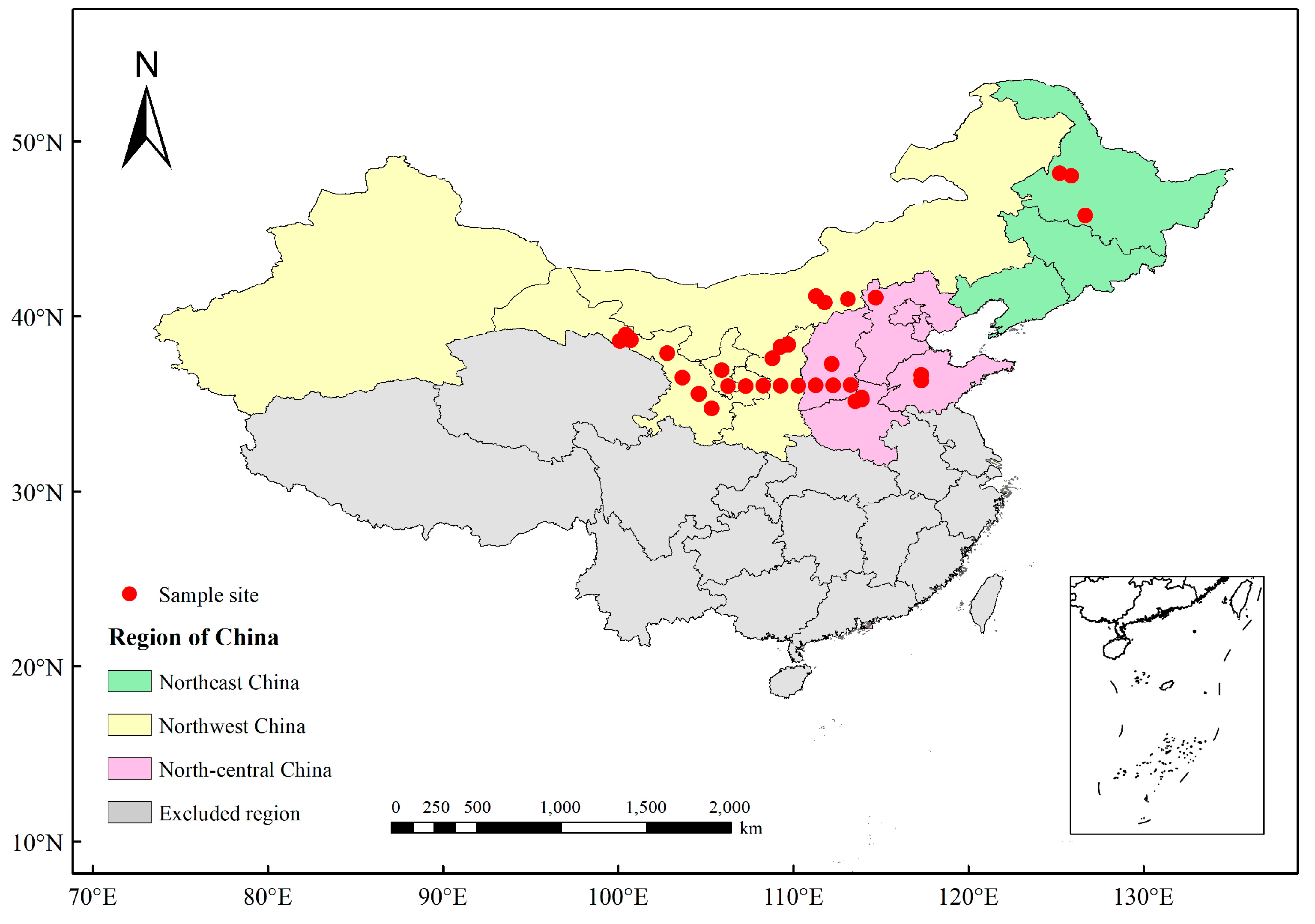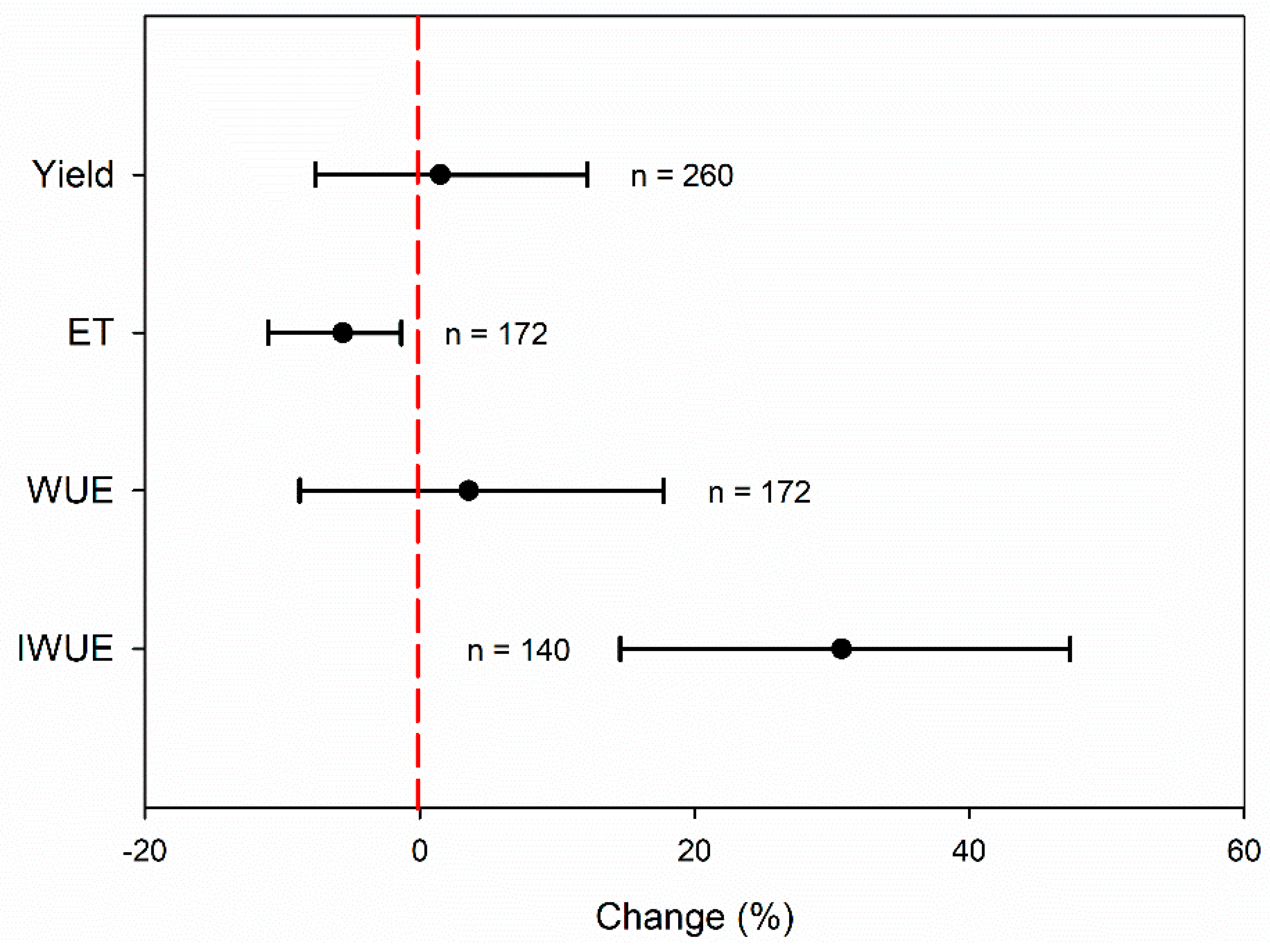Deficit Irrigation as an Effective Way to Increase Potato Water Use Efficiency in Northern China: A Meta-Analysis
Abstract
:1. Introduction
2. Materials and Methods
2.1. Literature Search and Data Collection
2.2. Statistical Analysis
3. Results
3.1. Overall Response of Potato Yield, ET, and WUE to Deficit Irrigation
3.2. Response of Potato Yield, ET, WUE, and IWUE to Deficit Irrigation in Different Regions
3.3. Response of Potato Yield, ET, WUE, and IWUE to Deficit Irrigation in Different Soil Types
3.4. Response of Potato Yield, ET, WUE, and IWUE to Deficit Irrigation in Different Soil Organic Carbon Content
3.5. Response of Potato Yield, ET, and WUE, IWUE to Deficit Irrigation as Affected by Water-Saving Ratio
3.6. Response of Potato Yield, ET, and WUE, IWUE to Deficit Irrigation as Affected by Fertilization Rate
3.7. Response of Potato Yield, ET, and WUE, IWUE to Deficit Irrigation as Affected by Irrigation Methods
4. Discussions
4.1. Overall Response of Potato Yield and WUE to Deficit Irrigation
4.2. Response of Potato Yield and WUE to Deficit Irrigation as Affected by Irrigation Methods and Growing Region
4.3. Response of Potato Yield and WUE to Deficit Irrigation as Affected by Soil Types, Soil Organic Carbon Content, and Water-Saving Ratio
4.4. Response of Potato Yield and WUE to Deficit Irrigation as Affected by Fertilizer Application Rate
5. Conclusions
Author Contributions
Funding
Data Availability Statement
Acknowledgments
Conflicts of Interest
References
- Si, J.; Wang, L.; Zhang, K.; Li, L.; Fudjoe, S.K.; Luo, Z. Irrigation as an Effective Way to Increase Potato Yields in Northern China: A Meta-Analysis. Agronomy 2024, 14, 448. [Google Scholar] [CrossRef]
- Du, T.; Kang, S.; Sun, J.; Zhang, X.; Zhang, J. An improved water use efficiency of cereals under temporal and spatial deficit irrigation in north China. Agric. Water Manag. 2010, 97, 66–74. [Google Scholar] [CrossRef]
- Wang, L.; Li, L.; Xie, J.; Luo, Z.; Sumera, A.; Zechariah, E.; Fudjoe, S.K.; Palta, J.A.; Chen, Y. Does plastic mulching reduce water footprint in field crops in China? A meta-analysis. Agric. Water Manag. 2022, 260, 107293. [Google Scholar] [CrossRef]
- Deng, X.; Shan, L.; Zhang, H.; Turner, N.C. Improving agricultural water use efficiency in arid and semiarid areas of China. Agric. Water Manag. 2006, 80, 23–40. [Google Scholar] [CrossRef]
- Abdelkhalik, A.; Pascual, B.; Nájera, I.; Baixauli, C.; Pascual-Seva, N. Deficit irrigation as a sustainable practice in improving irrigation water use efficiency in cauliflower under Mediterranean conditions. Agronomy 2019, 9, 732. [Google Scholar] [CrossRef]
- Yu, L.; Zhao, X.; Gao, X.; Siddique, K.H.M. Improving/maintaining water-use efficiency and yield of wheat by deficit irrigation: A global meta-analysis. Agric. Water Manag. 2020, 228, 105906. [Google Scholar] [CrossRef]
- Afshar, R.K.; Chaichi, M.; Assareh, M.; Hashemi, M.; Liaghat, A. Interactive effect of deficit irrigation and soil organic amendments on seed yield and flavonolignan production of milk thistle (Silybum marianum L. Gaertn.). Industrial Crops and Products 2014, 58, 166–172. [Google Scholar] [CrossRef]
- Galindo, A.; Collado-González, J.; Griñán, I.; Corell, M.; Centeno, A.; Martín-Palomo, M.; Girón, I.; Rodríguez, P.; Cruz, Z.; Memmi, H. Deficit irrigation and emerging fruit crops as a strategy to save water in Mediterranean semiarid agrosystems. Agric. Water Manag. 2018, 202, 311–324. [Google Scholar] [CrossRef]
- Del Moral, L.G.; Rharrabti, Y.; Villegas, D.; Royo, C. Evaluation of grain yield and its components in durum wheat under Mediterranean conditions: An ontogenic approach. Agron. J. 2003, 95, 266–274. [Google Scholar] [CrossRef]
- Kang, S.; Zhang, L.; Liang, Y.; Hu, X.; Cai, H.; Gu, B. Effects of limited irrigation on yield and water use efficiency of winter wheat in the Loess Plateau of China. Agric. Water Manag. 2002, 55, 203–216. [Google Scholar] [CrossRef]
- Bladia, R.; AbdArahman, S. Effect of water stress on pepper plant (Capsicum annum) var Albaladi. J. Al-Baath Univ. 2016, 38, 103–117. [Google Scholar]
- Ayas, S. The effects of irrigation regimes on the yield and water use of eggplant (Solanum melongena L.). Toprak Su Dergisi 2017, 6, 49–58. [Google Scholar] [CrossRef]
- Geerts, S.; Raes, D. Deficit irrigation as an on-farm strategy to maximize crop water productivity in dry areas. Agric. Water Manag. 2009, 96, 1275–1284. [Google Scholar] [CrossRef]
- Shammout, M.a.W.; Qtaishat, T.; Rawabdeh, H.; Shatanawi, M. Improving water use efficiency under deficit irrigation in the Jordan Valley. Sustainability 2018, 10, 4317. [Google Scholar] [CrossRef]
- FAO. FAO Statistical Databases. 2016. Available online: http://faostat3.fao.org/ (accessed on 1 December 2016).
- Su, W.; Wang, J. Potato and food security in China. Am. J. Potato Res. 2019, 96, 100–101. [Google Scholar] [CrossRef]
- Wang, L.; Coulter, J.A.; Palta, J.A.; Xie, J.; Luo, Z.; Li, L.; Carberry, P.; Li, Q.; Deng, X. Mulching-induced changes in tuber yield and nitrogen use efficiency in potato in China: A meta-analysis. Agronomy 2019, 9, 793. [Google Scholar] [CrossRef]
- Hanson, B.; May, D. Effect of subsurface drip irrigation on processing tomato yield, water table depth, soil salinity, and profitability. Agric. Water Manag. 2004, 68, 1–17. [Google Scholar] [CrossRef]
- Wang, L.; Li, Q.; Coulter, J.A.; Xie, J.; Luo, Z.; Zhang, R.; Deng, X.; Li, L.L. Winter wheat yield and water use efficiency response to organic fertilization in northern China: A meta-analysis. Agric. Water Manag. 2020, 229, 105934. [Google Scholar] [CrossRef]
- Xue, Q.; Zhu, Z.; Musick, J.T.; Stewart, B.; Dusek, D.A. Physiological mechanisms contributing to the increased water-use efficiency in winter wheat under deficit irrigation. J. Plant Physiol. 2006, 163, 154–164. [Google Scholar] [CrossRef]
- Liu, F.; Shahnazari, A.; Andersen, M.N.; Jacobsen, S.E.; Jensen, C.R. Effects of deficit irrigation (DI) and partial root drying (PRD) on gas exchange, biomass partitioning, and water use efficiency in potato. Sci. Hortic. 2006, 109, 113–117. [Google Scholar] [CrossRef]
- Adu, M.O.; Yawson, D.O.; Armah, F.A.; Asare, P.A.; Frimpong, K.A. Meta-analysis of crop yields of full, deficit, and partial root-zone drying irrigation. Agric. Water Manag. 2018, 197, 79–90. [Google Scholar] [CrossRef]
- Kifle, M.; Gebretsadikan, T. Yield and water use efficiency of furrow irrigated potato under regulated deficit irrigation, Atsibi-Wemberta, North Ethiopia. Agric. Water Manag. 2016, 170, 133–139. [Google Scholar] [CrossRef]
- Yactayo, W.; Ramírez, D.A.; Gutiérrez, R.; Mares, V.; Posadas, A.; Quiroz, R. Effect of partial root-zone drying irrigation timing on potato tuber yield and water use efficiency. Agric. Water Manag. 2013, 123, 65–70. [Google Scholar] [CrossRef]
- Wang, L.; Wang, S.; Chen, W.; Li, H.; Deng, X. Physiological mechanisms contributing to increased water-use efficiency in winter wheat under organic fertilization. PLoS ONE 2017, 12, e0180205. [Google Scholar] [CrossRef] [PubMed]
- Sepaskhah, A.R.; Ahmadi, S. A review on partial root-zone drying irrigation. Int. J. Plant Prod. 2010, 4, 241–258. Available online: https://sid.ir/paper/314589/en (accessed on 16 August 2010).
- Li, Q.; Li, H.; Zhang, L.; Zhang, S.; Chen, Y. Mulching improves yield and water-use efficiency of potato cropping in China: A meta-analysis. Field Crops Res. 2018, 221, 50–60. [Google Scholar] [CrossRef]
- Jabro, J.; Iversen, W.; Evans, R.; Stevens, W. Water use and water productivity of sugarbeet, malt barley, and potato as affected by irrigation frequency. Agron. J. 2012, 104, 1510–1516. [Google Scholar] [CrossRef]
- Wang, L.; Palta, J.A.; Chen, W.; Chen, Y.; Deng, X. Nitrogen fertilization improved water-use efficiency of winter wheat through increasing water use during vegetative rather than grain filling. Agric. Water Manag. 2018, 197, 41–53. [Google Scholar] [CrossRef]
- Asgharipour, M.R.; Heidari, M. Effect of potassium supply on drought resistance in sorghum: Plant growth and macronutrient content. Pak. J. Agri. Sci. 2011, 48, 197–204. [Google Scholar]
- Egilla, J.N.; Davies, F.T.; Drew, M.C. Effect of potassium on drought resistance of Hibiscus rosa-sinensis cv. Leprechaun: Plant growth, leaf macro-and micronutrient content and root longevity. Plant Soil 2001, 229, 213–224. [Google Scholar] [CrossRef]
- Seutra Kaba, J.; Abunyewa, A.A.; Kugbe, J.; Kwashie, G.K.; Owusu Ansah, E.; Andoh, H. Arbuscular mycorrhizal fungi and potassium fertilizer as plant biostimulants and alternative research for enhancing plants adaptation to drought stress: Opportunities for enhancing drought tolerance in cocoa (Theobroma cacao L.). Sustain. Environ. 2021, 7, 1963927. [Google Scholar] [CrossRef]










| Soil Types | Soil Textures | pH | Field Capacity (%) | Soil Organic Matter (%) |
|---|---|---|---|---|
| Chernozem | sandy loam | 7.0–8.5 | 30–33 | 2.0–8.0 |
| Brown soil | sandy loam | 5.5–7.0 | 25–30 | 5.0–6.0 |
| Yellow loam soil | clay loam | 4.0–6.0 | 30–40 | 1.0–2.0 |
| Huangmian soil | sandy loam | 7.5–8.5 | 20–28 | 0.3–1.0 |
| Gray desert soil | sandy loam | 8.0–9.0 | 17–20 | 0.6–1.5 |
| Meadow soil | sandy loam | 8.0–10.0 | 20–23 | 2.0–2.5 |
| Sierozem | sandy loam | 8.0–9.5 | 20–25 | 1.1–2.0 |
| Chestnut soil | sandy loam | 7.5–8.5 | 17–20 | 1.5–2.5 |
| Aeolian sandy soil | sandy soil | 8.0–9.0 | 15–18 | 0.1–1.0 |
Disclaimer/Publisher’s Note: The statements, opinions and data contained in all publications are solely those of the individual author(s) and contributor(s) and not of MDPI and/or the editor(s). MDPI and/or the editor(s) disclaim responsibility for any injury to people or property resulting from any ideas, methods, instructions or products referred to in the content. |
© 2024 by the authors. Licensee MDPI, Basel, Switzerland. This article is an open access article distributed under the terms and conditions of the Creative Commons Attribution (CC BY) license (https://creativecommons.org/licenses/by/4.0/).
Share and Cite
Niu, Y.; Zhang, K.; Khan, K.S.; Fudjoe, S.K.; Li, L.; Wang, L.; Luo, Z. Deficit Irrigation as an Effective Way to Increase Potato Water Use Efficiency in Northern China: A Meta-Analysis. Agronomy 2024, 14, 1533. https://doi.org/10.3390/agronomy14071533
Niu Y, Zhang K, Khan KS, Fudjoe SK, Li L, Wang L, Luo Z. Deficit Irrigation as an Effective Way to Increase Potato Water Use Efficiency in Northern China: A Meta-Analysis. Agronomy. 2024; 14(7):1533. https://doi.org/10.3390/agronomy14071533
Chicago/Turabian StyleNiu, Yining, Ke Zhang, Khuram Shehzad Khan, Setor Kwami Fudjoe, Lingling Li, Linlin Wang, and Zhuzhu Luo. 2024. "Deficit Irrigation as an Effective Way to Increase Potato Water Use Efficiency in Northern China: A Meta-Analysis" Agronomy 14, no. 7: 1533. https://doi.org/10.3390/agronomy14071533





